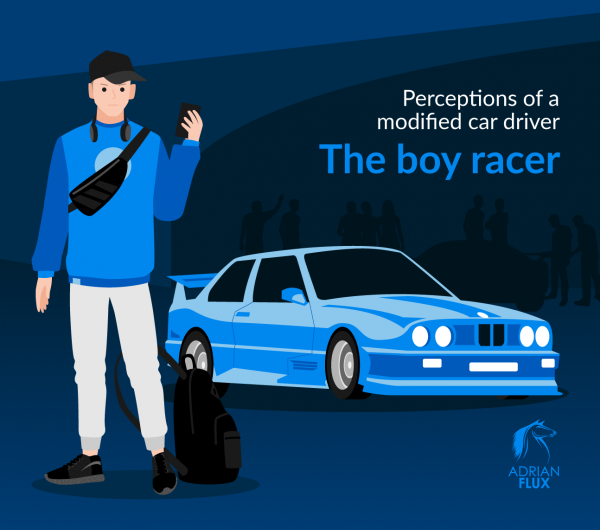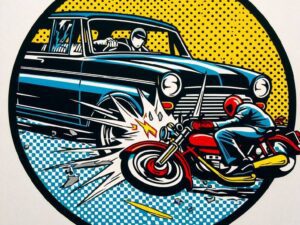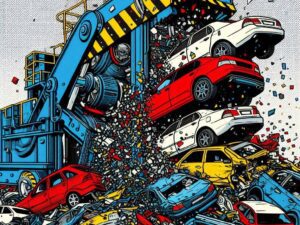Modification Nation: perceptions vs. reality of car modification in the UK

Car modifications in the UK have been popular for generations. However, there are still some outdated beliefs held by the general public about who alters their cars.
We wanted to know what the public thought about those who modify their cars. Who are they? How old are they? What modifications do they get? And which ones are actually legal? After surveying the public and analysing our own data on genuine modifications, we were able to compare and contrast the perceptions versus the reality of modifying cars in the UK, as well as informing the public on which modifications fall under the law.
The law: over half of drivers did not know to declare their modifications
Before we asked the public what they thought of car modifiers, we wanted to know what the UK’s drivers knew about the laws surrounding modifications. Does everyone know the regulations around upgrading their vehicles? Let’s find out.
52% of drivers in the UK are unaware that they must declare all vehicle modifications to their insurer. Regardless of whether a modification was implemented to improve the safety of a car, if the vehicle has been changed this can alter its appearance (potentially making it unrecognisable in the event of an accident) and alter its value. Some modifications can even increase the likelihood of the car being in an accident. However, despite what many people think, by declaring your modifications you can often save money on your insurance.
“As the government considers new legislation to tighten the parameters on permissible car modifications to improve both safety and the environmental impact of vehicles, it is clear there is a gap in the public’s knowledge already when it comes to making upgrades to their vehicles,” says Matt Allen, Product, Pricing and Underwriting Manager. “At Adrian Flux, we understand the true value of modifications, and as specialists understand that many modders make changes to their cars that make them safer than the vehicles of the average driver – we hope these modifications will not fall foul of the government’s Modernising Vehicle Standards plan when it is revealed in due course.”
What’s legal and what’s changing?
There are several modifications that the general public believes to be illegal and has consciously avoided:
38% of people thought the use of nitrous oxide was illegal. However, this is not the case. Nitrous oxide is used to increase the output of an engine.
26% of people thought under-car neon lights were. In fact, these lights are entirely legal as long as they are not directly visible and do not flash.
Mood lighting was also a common misconception, with 22% of people thinking it was illegal.
22% of the general public also believe that window tints are against the law. Tinting windows are legal, as long as they have over 75% light transmission.
29% of people also thought that any form of exhaust modification was illegal, which is not the case – drivers are only prohibited from making their vehicles louder (potentially with big-bore and sports exhausts) than permitted for their vehicle category.
A new ‘tampering legislation’ is currently under discussion by the government under the Modernising Vehicle Standards plan. This new piece of legislation could have huge implications on the modifications that are currently deemed legal – yet 71% of people were not aware of these implications. The legislation will target modifications that have a negative impact on road safety, vehicle security and the environment.
Fast and furious: the boy racer perception

When asked about the age group that is most likely to modify their car, the general public pointed to the younger generations: 47.6% think that 17-24-year-olds are the most inclined to upgrade their auto. This is followed by 23% who said that 25-34-year-olds are most keen.
The public also believed that it’s men who are most interested in modifications, with 83% of respondents choosing them as the most likely to modify cars.
We also asked for the character traits most associated with car modifiers. The top results were overwhelmingly negative, including ‘laddish’ and ‘dangerous’. While positive personality traits were available in our survey, they weren’t favoured: only 2% of people considered modifiers ‘economical’, 2.6% saw them as ‘safety-conscious’ and 3% thought they were ‘sensible’.
Personality traitsPercentage of people who think these traits are associated with car modifications
Laddish44%
Attention-seeking39%
Loud31.5%
Dangerous or reckless26%
When pairing these traits with young men, it’s clear to see that the boy racer persona, which gained notoriety in the 2000s due to pop culture phenomena like Pimp My Ride and the Fast & Furious franchise, remains at the forefront of people’s minds. This was emphasised when our respondents chose behaviours they associated with car modifiers:
BehavioursPercentage of people who think these behaviours are associated with car modifications
Playing loud music43.6%
Cruising around town43%
Hanging out in car parks38%
Hanging out in large groups34.6%
The real modifier: 45-54 year-olds retirees

While our general public may believe that young men with a booming sound system are the most likely to invest in auto alterations, the reality might surprise them.
It’s true that men are the most likely to modify cars, but the actual figures are even higher than the public predicted, with men accounting for 85.8% of modifications enthusiasts. When it comes to age, though, the public’s assumptions were much further from the truth. Most modifications are carried out by 45-54 year-olds (24.79%) and 55-64 year-olds (24.5%). In fact, 17-24-year-olds only account for 2% of modifications. When looking at the professions of modifiers, retirees were ranked the highest with 9.3% of the car-altering population having left their jobs.
Classic cars are the most likely to be modified
We felt it also important to take a look at the types of cars that are being modified, as well the modifications being made. The vehicle manufacturer has a significant impact on our perceptions of modifications, and we wanted to see which brands people thought were most likely to be altered – and for what purpose.
Those surveyed thought the following makes of car were most likely to be modified by their owner:
Car manufacturersPercentage of people who think these cars are the most likely to be modified
BMW45.5%
Ford40.9%
Audi32.4%
Our public thinks BMW, Ford and Audi vehicles are the most likely to be upgraded, but it is actually Volkswagens that are most often modified. According to our exclusive data, VWs account for 18.72% of modifications, followed by Land Rovers, which make up 13.16% of alterations.
The only brand that features in the top three for both perception and reality, albeit with vastly different percentages, is Ford. 10.37% of actual modifications are to Ford vehicles, four times less than the public’s guess.
Alloy wheels and paint jobs: the most popular modifications
While we’ve looked at the people behind the modifications, it’s time to evaluate what changes are being made to cars. The types of modifications associated with boy racers are system changes designed to make cars louder, larger and to grab more attention. These can include alloy wheels, non-standard paintwork, suspension changes and tinted windows.
However, many of these changes can also improve performance and safety, or can simply make a car more practical and user friendly.
Below are some of the most popular modifications:
RankingModificationPercentage of all modifications
1Alloy wheels30.24%
2Non-standard engine11.96%
3Adapted for disability10.95%
4Air filters5.24%
5Exhaust system changes5.18%
6Suspension changes3.2%
9Non-standard paintwork2.11%
43LPG conversions0.21%
55Tinted windows0.14%
59Towbars0.12%
Alloy wheels are the most popular modification. They’re lighter than standard steel wheels, and are often used to improve ride handling and suspension performance. While they may be associated with the perceived danger-seeking desires of a boy racer, alloys can actually improve the general safety of the car.
Engine changes are the second most popular alteration, which, along with LPG conversions, can change the fuel type to be more environmentally and economically efficient. Adaptations for disabilities, including changing hand controls and installing ramps, are the third most popular modification – a far cry from the public’s assumption that modifications are ‘reckless’.
Air filters are often installed to improve air quality in the vehicle and prevent dirt from reaching the engine, while exhaust system changes can be considerate alterations to make vehicles quieter and stop noise pollution. Towbars are a very practical modification, installed for the purpose of connecting one vehicle to another.
Insure your modified car with Adrian Flux
As we’ve seen, there is little truth to the ‘boy racer’ persona associated with car modifications. While the public believes the average modifier to be disruptive – loud, cruising around urban areas and hanging out in large groups – the majority are retired men aged 45 installing practical, performance-based features to their vehicle.
No matter your age, gender or car type, if you’ve modified your car, you’ll need to let your insurer know. At Adrian Flux, we offer specialist cover for modified vehicles, ensuring you get the best deal for your car. Get in touch today for a competitive quote.






